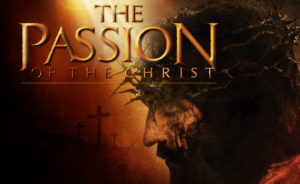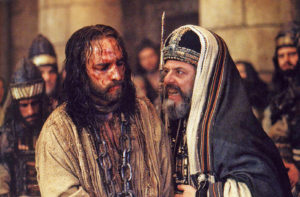This commentary about the then recently released movie, The Passion of the Christ, was published on March 10, 2004 in The Kansas City Kansan as the centerpiece of my weekly Crum on Film column. I never reviewed the movie, but instead saw it after its release at an area theater. (I would have given it an “A,” however.) Of the over 2,000 films I have reviewed and probably another thousand referenced in my columns over the decades, this one turned out to be my most controversial. I do not tout my religious convictions, either publicly or privately, but I did here—to a degree. I stop way short of my being labeled a Bible thumper or the like. At least I tried not to go that far. That I went as far as I did should be credited to Mr. Gibson and his remarkable work.
 By Steve Crum
By Steve Crum
There was no outright sobbing at the mostly packed theater when I saw The Passion of the Christ, but there was quiet solemnity. Friends have since told me that many at their screenings were loudly crying. Recently, a sixth grader eagerly shared with me that not only did he cry, but so did his parents and young brothers and sisters. “Everybody was crying at that show!”
Remember that The Passion is an “R” rated film, so children must be accompanied by parents. Realize too that the movie is considered with good reason the most violent film ever made. “If The Passion weren’t about Jesus,” said one critic, “the rating would be NC-17.”
But it IS about Jesus, and that is precisely the point. The fact that The Passion made an incredible $125 million in its first five release days is testament…sorry, Testament.
 Certainly the controversy surrounding the role Jews played in the arrest, torture, and eventual crucifixion of the Son of God has helped more than hurt the movie’s box office. Both curiosity seekers and true believers filled those seats, and continue to do so. The bottom line is Mel Gibson, the Lord love him—and I believe He does, has succeeded in producing and directing the first major motion picture ever that is both spiritually and historically challenging.
Certainly the controversy surrounding the role Jews played in the arrest, torture, and eventual crucifixion of the Son of God has helped more than hurt the movie’s box office. Both curiosity seekers and true believers filled those seats, and continue to do so. The bottom line is Mel Gibson, the Lord love him—and I believe He does, has succeeded in producing and directing the first major motion picture ever that is both spiritually and historically challenging.
From this Christian’s viewpoint, the Jewish depictions are probably apt. I say this with sensitivity to the Jewish religion and without malice or anti-Semitism. The film shows the religious leaders, who happened to be Jewish, as feeling threatened by Jesus Christ and then aggressively seeking his demise through their Roman governor. Throughout history, religious factions too often used violence against their enemies, whether or not the “enemies” were justifiably so. Both Catholics and Christians perpetrated their own Inquisitions and Crusades in the name of religion. It just so happened Jews were involved with Christ’s last days on earth. That is my possibly too simplistic take on the controversy of The Passion of the Christ.
 Technically, Gibson’s direction is taut, vivid, and subjective. His cameras pull us into the scenes, often crossing the line into the discomfort zone, like someone talking to you but getting too near your face in the process. In The Passion, that includes the relentless scenes (a good 90 minutes of the two hours, seven-minutes film) of actor James Caviezel’s Jesus being whipped, clubbed, and kicked until his outer skin is gone. We feel literally close to the pain through extreme close-up visuals and sound effects.
Technically, Gibson’s direction is taut, vivid, and subjective. His cameras pull us into the scenes, often crossing the line into the discomfort zone, like someone talking to you but getting too near your face in the process. In The Passion, that includes the relentless scenes (a good 90 minutes of the two hours, seven-minutes film) of actor James Caviezel’s Jesus being whipped, clubbed, and kicked until his outer skin is gone. We feel literally close to the pain through extreme close-up visuals and sound effects.
A fellow critic complained to me, “Gibson made his point 10 minutes into the film, so why did he have to give us two more hours of needless violence?” My response: Gibson’s point is that Christ DID suffer more than 10 minutes during his final hours. He suffered more than any normal human could or should suffer, and yet he survived—barely—to carry his own cross over a long, uphill road, to bear even more pain of nails, thirst, and degradation And then forgave those who did all this to him.
 But does this message justify what some call Gibson’s glorification of torture upon Christ? Yes. I say this even though Gibson used a similar tact in the horrifying disembowelment of Scotland’s rebel hero William Wallace in 1995’s Braveheart. In a literary sense, no sacrilege intended, both Christ and Wallace were martyrs…with Christ being the supreme martyr. The fact that Mel Gibson made these two blockbuster films that are also graphically violent makes Passion an easy target for naysayers.
But does this message justify what some call Gibson’s glorification of torture upon Christ? Yes. I say this even though Gibson used a similar tact in the horrifying disembowelment of Scotland’s rebel hero William Wallace in 1995’s Braveheart. In a literary sense, no sacrilege intended, both Christ and Wallace were martyrs…with Christ being the supreme martyr. The fact that Mel Gibson made these two blockbuster films that are also graphically violent makes Passion an easy target for naysayers.
The Passion is not for the faint of heart. Whether it is for young children to see is up to parents. For believers, it is the most credible telling of Christ’s suffering in the history of film. Although I am very glad I saw The Passion of the Christ, for both religious and critical reasons, a second viewing would be too traumatic.
=====
